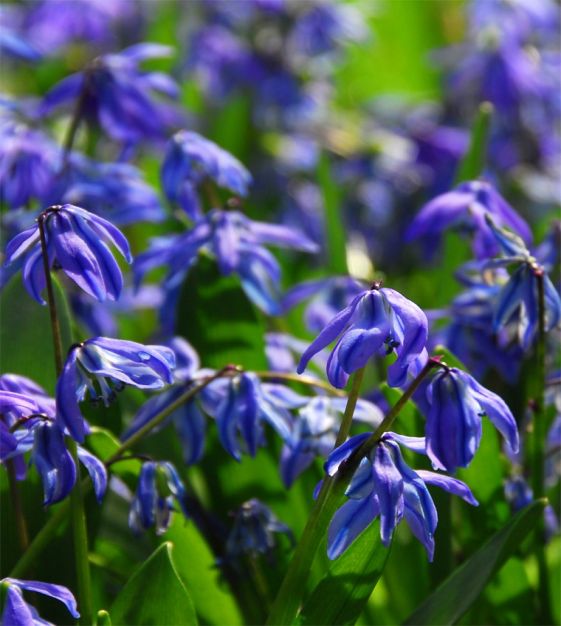-
- Website Specials
- New for 2025!
- Tulips
- Narcissi
- Allium
- Anemone blanda
- Brodiaea
- Camassia
- Chionodoxa
- Corydalis
- Crocus
- Eranthis
- Eremurus
- Erythronium
- Fritillaria
- Galanthus
- Geranium
- Gladiolus
- Hyacinths
- Hyacinthoides
- Ipheion uniflorum
- Dutch Iris
- Rock Garden Iris
- Ixiolirion
- Leucojum Aestivum
- Muscari
- Ornithogalum
- Oxalis
- Puschkinia
- Scilla
- Lilies
- Peonies
- Tender Bulbs
- Anemone Giants
- Tecolote Ranunculus
- Freesias
- Paperwhites
- Amaryllis
Scilla siberica Spring Beauty
Circa 1796, the Siberian Squill bears up to six, drooping, vivid sky-blue flowers on strong stems to emblazon woodland floors, rock gardens and garden borders. It is particularly lovely planted underneath white Narcissi. One of the most widely planted of all special miscellaneous bulbs, Spring Beauty naturalizes readily in areas of light shade or dappled sunlight. When it’s really happy where planted, it can naturalize by both bulb offsets (baby bulbs on the sides of the mother bulb you’ve planted) and self-sowing seed. You’ll need about nine bulbs per square foot. (Square footage is determined multiplying the planting site’s length times its width.) In woodland settings, you can also scatter-plant the bulbs for a more natural look.
This year's harvest has produced top size bulbs 7/8 cm. Full to partial sunlight. Bloom time in horticultural zone 5: April. Plant 5" deep and 4" to 6" apart. HZ: 3-8. Height: 5". (Scilla are also good for forcing: pot them up in mid-October, precool them at a consistent, dark 38° to 45°F for six to eight weeks with moderate watering. Bring them into the house~they will bloom about two to four weeks later.)
Scilla are The Art & Soul of Spring.
Scilla Horticultural Tips Stinze Plantings
Scilla are The Art & Soul of Spring.
Scilla Horticultural Tips Stinze Plantings
- Information
Scilla
For decades, perhaps generations, Hyacinthoides and Scilla have been classified and reclassified together as Scilla or Endymion, or apart, as they are today, as Hyacinthoides and Scilla. They are deer- and rodent-resistant, prefer a bit of light shade and naturalize readily in both woodland settings and display gardens, becoming increasingly more substantial and prolific over time. Economical for large woodland drifts or garden border swaths, you’ll be amazed over the transformative impact that these little bulbs have over time.
Scilla are The Art & Soul of Spring.
Scilla Horticultural Tips Stinze Plantings
For decades, perhaps generations, Hyacinthoides and Scilla have been classified and reclassified together as Scilla or Endymion, or apart, as they are today, as Hyacinthoides and Scilla. They are deer- and rodent-resistant, prefer a bit of light shade and naturalize readily in both woodland settings and display gardens, becoming increasingly more substantial and prolific over time. Economical for large woodland drifts or garden border swaths, you’ll be amazed over the transformative impact that these little bulbs have over time.
Scilla are The Art & Soul of Spring.
Scilla Horticultural Tips Stinze Plantings
Scilla
For decades, perhaps generations, Hyacinthoides and Scilla have been classified and reclassified together as Scilla or Endymion, or apart, as they are today, as Hyacinthoides and Scilla. They are deer- and rodent-resistant, prefer a bit of light shade and naturalize readily in both woodland settings and display gardens, becoming increasingly more substantial and prolific over time. Economical for large woodland drifts or garden border swaths, you’ll be amazed over the transformative impact that these little bulbs have over time.
Scilla are The Art & Soul of Spring.
Scilla Horticultural Tips Stinze Plantings
For decades, perhaps generations, Hyacinthoides and Scilla have been classified and reclassified together as Scilla or Endymion, or apart, as they are today, as Hyacinthoides and Scilla. They are deer- and rodent-resistant, prefer a bit of light shade and naturalize readily in both woodland settings and display gardens, becoming increasingly more substantial and prolific over time. Economical for large woodland drifts or garden border swaths, you’ll be amazed over the transformative impact that these little bulbs have over time.
Scilla are The Art & Soul of Spring.
Scilla Horticultural Tips Stinze Plantings





